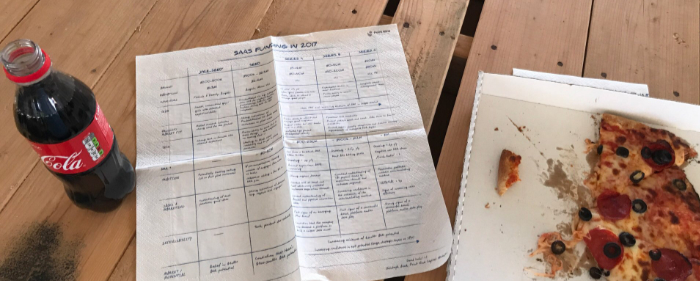As the founder and chairman of The Finnish Software Industry and Entrepreneur Association's (Ohjelmistoyrittäjät ry) SaaS club, I have followed quite many Software-as-a-Service companies and entrepreneurs over the last 8 years, seen many to succeed, and many more who haven’t. So what are the biggest mistakes I have seen? This post is based on my answer to that question on Quora.
Although the question was about SaaS companies, my answer may be relevant to you as well even if you are not in SaaS business.

The biggest mistakes are made when laying the foundation
Oh boy, the amount of mistakes a SaaS company can and will make are numerous. The really successful ones must have made thousands of mistakes, and navigated through them the most to get to the top. The faster you grow, the more mistakes you are likely to make, as decisions have to be done at high speed with very limited information. It's a small wonder they even survive.
But one might argue these are not mistakes, but experiments, and the purpose of a startup is to learn fast. To learn fast, you have to experiment a lot and fail fast.
However, let's forget the variety of mistakes and zoom into the the topic of biggest mistakes. And these mistakes are made early on while the foundation is layed.
#1: Building a product first, then trying to find market for it
I see so, so many SaaS companies with great solutions desperately searching for a problem.
Sure they have all started by solving a problem, for a customer or customers perhaps. But each customer tends to have a unique problem, and problems start when the product is developed to solve a generalised problem which is not understood properly.
First you have to understand the problem properly.
Who has the problem?
This is a really complex question especially in B2B context where e.g. “who” can mean the organization and each stakeholder together or separately.
“Has” can mean various levels of identifying the problem from “no need identified yet” to “looking for a vendor”.
"Can you solve my problem?"
In B2B space everyone tends to have unique needs. If most are already looking for a vendor, a flexible product that can fit to various cases easily is an advantage.
"What does your product do?"
If few have identified the need, a flexible product is often a liability as it's hard to communicate the benefits clearly, and the marketing message can often be distilled to:
"Whatever you want it to do!"
It is common that early customers represent those few who have seen the light, and their requests lead development to broaden the product rather than make it sharper and thus clearer to communicate to those still in the dark.
Are they willing and capable to solve the problem?
A common truth is that customer lies, you just don't know how much and where.
Every smoker would like to stop smoking, and unfit would like to get fit if asked. They might even say that they plan to do so. Yet few do. Same applies to organisations.
Thus much what customers say is just smoke and mirrors: wishful thinking, dreaming, hoping, answering what is expected to answer.
My experience at Loyalistic is that feature requests by prospects are mostly lies. If a prospect says that they would buy Loyalistic if it has a feature we haven't yet built, they will not buy it even if we build it the next day. Done that, been there. And even if they are willing to buy with the promise that the feature is built, they won't start using that feature any quicker than the rest of the customers.
Who understands the problem better, solves it better
Product development is really a race to define and understand the problem better than to solve a poorly understood problem better.
“If I had an hour to solve a problem I'd spend 55 minutes thinking about the problem and 5 minutes thinking about the solutions.” - Albert Einstein
#2: Building for a best practice
In B2B space, it is so common to build a "best practice" product to a latest management etcetera fab of the day.
The problem comes from the word "best".
"Best" is the right way to do something, yet that is often so hard to achieve that very few reach the level where they could reasonably consider needing, let alone using, such a product.
You have to sell the fab first, then teach customers how to get there before you can sell the best practice SaaS product to them.
Yes, this is lucrative for consultants or more traditional software companies who sell lots of professional services on the side.
But SaaS is a volume business, and best practice is seldom scalable.
Make simple instead
However, "practical practice" is where volume can be made.
That is making something simple.
But this also means your product is not doing things "right" and you face lots of negative comments from those "in the know".
That's what we have been doing. Content marketing is potentially very effective and suites well to most B2B companies with plenty of expertise their customers value. But to turn that into effective inbound requires complex marketing automation tools, expertise and time most won't have. Thus Loyalistic makes content marketing to effective inbound and so simple any business can succeed. Give us a try.
#3: Start selling locally while aiming global
The third one is to start selling locally.
Almost all SaaS companies and most B2B startups I have met have global ambitions but they start selling locally.
Sure you know people, who know people... and you’ll find some traction there.
Yes, you should do things that won't scale while starting up, but...
The way to reach global market is way different than local.
You are likely to use inbound tactics, sell online or at least remotely and create content in English for global market.
But when you start locally, you tend to use outbound tactics, face to face meetings and local language. Your operation is sales driven, not marketing driven (with sales).
Soon it's unclear whether success is poor or good because of the product or because of the sales skills.
And after a while, you have built a nonscalable local field sales operation optimised for local market when the only option for going global is to apply the same to the next country.
This leads to slow expansion with local sales operation country by country.
I have yet to see a SaaS company who has managed to change this model later on to a scalable global, inbound driven operation in English.
And yes, we have made that mistake. Twice.
Some have local and international operations where the international is inbound driven while the local is traditional sales driven. Yet, even this is a huge challenge for the leadership as they are essentially trying to make two different business models work at the same time. Not much success here.
I hope some of this insight is valuable for you and helps avoid these common big mistakes that often lead a SaaS startup to a slow growth.
 |
Written by Antti Pietilä Antti is the founder and CEO at Loyalistic (Simple Content Marketing Software for B2B Companies) who loves to help SaaS-companies to grow at Software Entrepreneurs (@ohjelmisto_ry) and cycle. Say hello to him anytime @anttipietila. |
